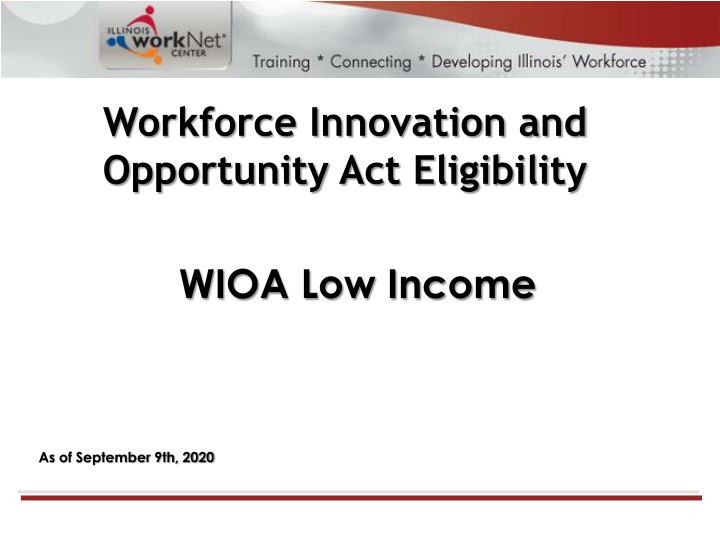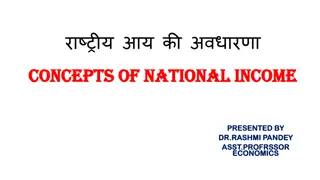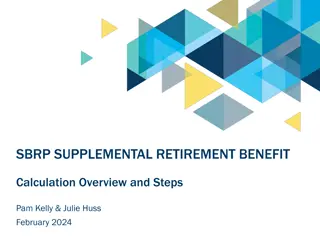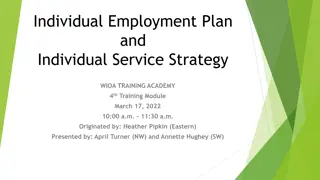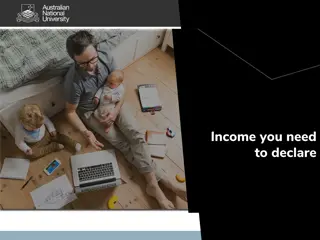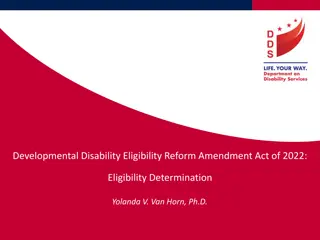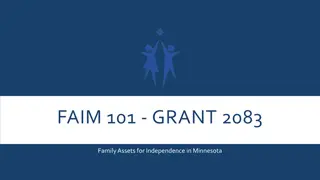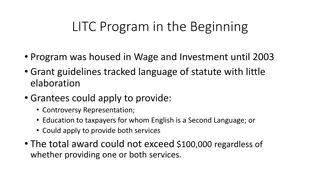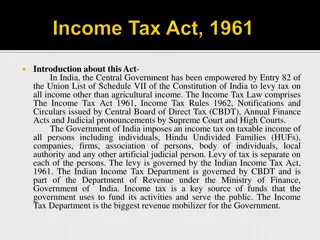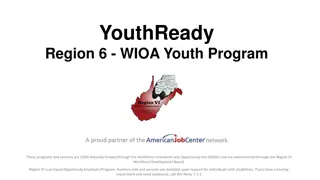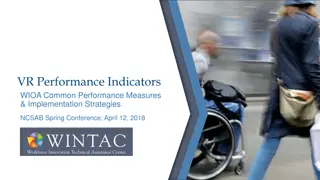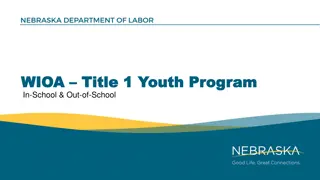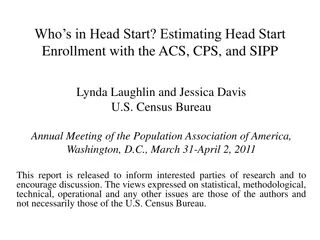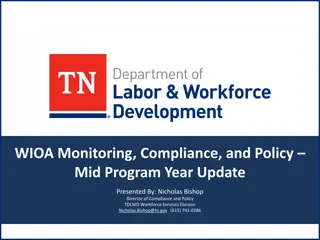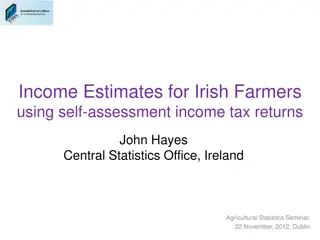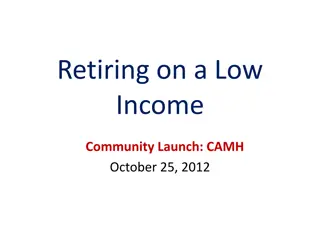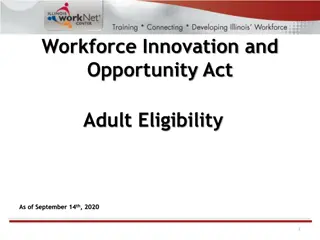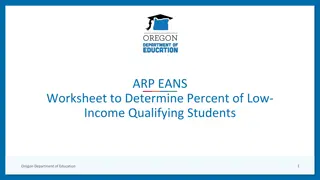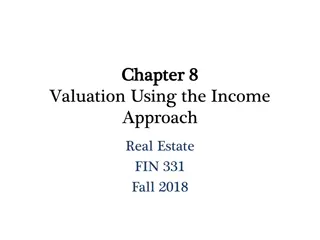WIOA Low-Income Eligibility Criteria Overview
Learn about the Workforce Innovation and Opportunity Act (WIOA) low-income eligibility criteria as outlined in the WIOA Title 1 Authorization. Understand the different ways individuals can qualify as low-income and the documentation required. Explore the priority of service for low-income individuals under WIOA programs.
Download Presentation

Please find below an Image/Link to download the presentation.
The content on the website is provided AS IS for your information and personal use only. It may not be sold, licensed, or shared on other websites without obtaining consent from the author.If you encounter any issues during the download, it is possible that the publisher has removed the file from their server.
You are allowed to download the files provided on this website for personal or commercial use, subject to the condition that they are used lawfully. All files are the property of their respective owners.
The content on the website is provided AS IS for your information and personal use only. It may not be sold, licensed, or shared on other websites without obtaining consent from the author.
E N D
Presentation Transcript
Workforce Innovation and Opportunity Act Eligibility WIOA Low Income As of September 9th, 2020
WIOA Title 1 Authorization Federal: Workforce Innovation and Opportunity Act of 2014 State of Illinois: Department of Commerce Office of Employment and Training (OET) WIOA E-Policy Chapter 5.5 - Low-Income Individuals
WIOA Low Income Additional guidance provided in Training and Employment Guidance Letter (TEGL) 19-16 Guidance on Services Provided through Adult and Dislocated Worker under WIOA dated March 1st, 2017. Additional guidance provided by TEGL 21-16 Third WIOA Title I Youth Formula Program Guidance dated March 2nd, 2017. 3
WIOA Low Income Rules Adult Program - Priority of service for low income individuals. In-School Youth 95% of clients must meet WIOA low income criteria. Out-of-School Youth Youth with certain barriers can be required to meet low income criteria. 4
Low Income Individual Policy WIOA E-Policy Chapter 5.5 - Low-Income Individuals. Attachment A Documentation Attachment B Inclusions/Exclusions WIOA Notice NO. 19-NOT-03. 5
The eight ways an applicant can become qualified as Low Income 1. Cash Welfare 2. Food Stamps 3. Homeless 4. Free or Reduced Priced Lunch 5. Foster Child 6. Youth Customer Living in a High Poverty Level 7. Family Income Calculation 8. Family of One Due to Disability 6
Low Income Only Requires One To meet WIOA Low income criteria, a client would only need to meet one of the eight different low income criteria. However, if a client claims to meet low income criteria multiple ways, then the expectations at eligibility determination would be to have verification documentation for each criteria claimed. 7
WIOA Low Income Criteria that does not require an income calculation 1. Cash Welfare 2. Food Stamps 3. Homeless 4. Free or Reduced Priced Lunch 5. Foster Child 6. Youth Customer Living in a High Poverty Level 8
WIOA Low Income Criteria The criteria for Cash Welfare and Food Stamps is: Personally receives, or is a member of a family that receives or received in the past six (6) months either Cash Welfare or Food Stamps. 9
Low Income: Cash Welfare 1. Temporary Assistance for Needy Families (TANF) program under Part A of Title IV of the Social Security Act, or 2. Supplemental Security Income (SSI) program established under Title XVI of the Social Security Act, or 3. State or local income-based public assistance. No Income Calculation Needed 10
The WIOA definition of Family The term family means two or more persons related by blood, marriage, or decree of court, who are living in a single residence, and are included in one or more of the following categories: A. Married couple and dependent children. B. Parent or guardian and dependent children. C. Married couple. 11
Question about Family ? Referring to the WIOA family definition; Charlie and Betty live together and they are not married, they have a son, Tommy. Q - Betty comes in, how many people are in her WIOA defined family and who are they? 12
Question about Family ? Referring to the WIOA family definition; Charlie and Betty live together and they are not married, they have a son, Tommy. Q - Betty comes in, how many people are in her WIOA defined family and who are they? A Family size of two, Betty and Tommy. Based on the WIOA Definition of family, to be considered a family of three in this situation, Charlie and Betty would need to be married. 13
The Public Assistance Screen is where the various Cash Welfare and Food Stamps eligibility criteria are captured. 14
Low Income: Cash Welfare 1. Temporary Assistance for Needy Families (TANF) program under Part A of Title IV of the Social Security Act, or 2. Supplemental Security Income (SSI) program established under Title XVI of the Social Security Act, or 3. State or local income-based public assistance. No Income Calculation Needed 15
Public Assistance If Yes is entered on the IWDS Public Assistance screen for following: Transitional Assistance Refugee Help SSI TANF The client will be determined low income based on Cash Welfare . 16
Question about Cash Welfare Q Betty is currently receiving TANF benefits, she lives with Charlie, but they are not married and Charlie is not on the household determination of the TANF printout. If Charlie came in for Services, could he be determined low income because he lives with Betty and she receives TANF benefits?
Answer to ? about Cash Welfare Q Betty is currently receiving TANF benefits, she lives with Charlie, but they are not married and Charlie is not on the household determination of the TANF printout. If Charlie came in for Services, could he be determined low income because he lives with Betty and she receives TANF benefits? A No, Charlie could not be determined as low income under WIOA due to Betty receiving TANF, as they do not meet the criteria under the family definition since they are not married.
The WIOA definition of Family The term family means two or more persons related by blood, marriage, or decree of court, who are living in a single residence, and are included in one or more of the following categories: A. Married couple and dependent children. B. Parent or guardian and dependent children. C. Married couple.
If the TANF is populated with Yes , the DHS Case # must be provided and the number of months the individual has been on TANF must be included.
Low Income: Food Stamps Personally receives, or is a member of a family that receives or received in the past six (6) months the Supplemental Nutrition Assistance Program (SNAP) assistance. Food and Nutrition Act of 2008 22
If Food Stamp and TANF are populated with Yes at certification, the documentation must be on hand to support both criteria. The documentation must remain in the hard copy file for monitoring and data validation.
Question about Food Stamps Q Betty is currently receiving Food Stamps, her son Tommy lives with her. If Tommy came in for WIOA Services could he be determined low income based on food stamps, even if he does not appear on his mothers food stamp account?
Answer to ? about Food Stamps Q Betty is currently receiving Food Stamps, her son Tommy lives with her. If Tommy came in for WIOA Services could he be determined low income based on food stamps, even if he does not appear on his mothers food stamp account? A WIOA Low Income criteria can be determined based on, Personally receives, or is a member of a family that receives or received in the past six (6) months the Supplemental Nutrition Assistance Program (SNAP) assistance. Since Tommy lives with his mom who is receiving food stamps, he could be determined low income based on his mother Betty receiving food stamps.
Low Income: Homeless 1. Individual who lacks a fixed, regular or adequate nighttime residence; and Violence Against Women Act of 1994 2. Adult or youth with a primary nighttime residence that is a public or privately operated shelter for temporary accommodation. McKinney-Vento Homeless Assistance Act
If Yes is entered in Homeless the client will be determined as low income.
Low Income : Free or Reduced Priced Lunch Receives or is eligible to receive a free or reduced price lunch under the Richard B. Russell National School Lunch Act -> Criteria for In-School Youth Only Must have documentation from school.
Low Income : Free or Reduced Priced Lunch TEGL 21-16 and our Low Income Policy clarified that In schools where the whole school automatically receives free or reduced price lunch, WIOA programs must base low-income status on an individual student s eligibility to receive free or reduced price lunch or on meeting one of the other low-income categories under WIOA Meaning if only whole school criteria is used for free or reduced lunch, you cannot use this method to determine low income criteria and must use one of the other low income categories to determine an individuals low income status 29
Youth Barriers Screen Youth Barriers screen is where the Free or Reduced Price Lunch question is housed if an in-school youth client has a response of Yes the client will be determined as low income. 30
? about Free or Reduced Lunch Documentation Q Sally is currently a Junior in H.S., and in the school district she attends, all students are eligible for free lunch. She has applied for WIOA services, what documentation would be needed to support her WIOA Low Income Criteria due to free or reduced lunch? 31
Answer to ? about Free or Reduced Lunch Documentation Q Sally is currently a Junior in H.S., and in the school district she attends, all students are eligible for free lunch. She has applied for WIOA services, what documentation would be needed to support her WIOA Low Income Criteria due to free or reduced lunch? A The documentation would need to specifically address that Sally herself, by name, is eligible for free or reduced lunch. If the school will not provide information about an individual, then the client must find another way to support WIOA Low Income criteria. 32
Low Income: Foster Child A minor on behalf of whom State or local government payments are made to a foster parent or other guardian.
Characteristics and Barriers screen is where the Foster Child question is housed if any client has a response of Yes to Foster Child - the client will be determined as low income.
Question about Foster Child Documentation Q Conrad is currently a Senior in H.S., he lives with his foster parents. What is the documentation that could be used support his WIOA Low Income Criteria due to Foster Child status? 35
Question about Foster Child Documentation Q Conrad is currently a Senior in H.S., he lives with his foster parents. What is the documentation that could be used support his WIOA Low Income Criteria due to Foster Child status? A The documentation choices to support Foster Child status to support WIOA Low Income criteria are listed in Attachment A to Commerce WIOA Low Income Policy WIOA E-Policy Chapter 5.5: To support foster child status the following are acceptable choices: Court Contact; Court Documentation; Medical Card showing Foster Child Status; Verification of Payment made on behalf of the child; Written Statement from State/Local Agency
Youth Living in a High Poverty Level According to Section 129(a)(2) of WIOA, for ISY and OSY, a youth qualifies as low income if the youth lives in a high poverty area. Many rural counties in the U.S. have a poverty rate of 25 percent or above. New Guidance was issued in April 2020 on the steps to determine this criteria. The next few slides provides additional guidance on these new steps.
New Guidance in April 2020 DIRECTIONS FOR USING AMERICAN COMMUNITY SURVEY DATA TO IDENTIFY HIGH-POVERTY AREA IN URBAN OR RURAL AREAS Note that these are new directions given that the Census Bureau has changed its web site since last year for obtaining American Community Survey Data. Section 1: Determining if an Overall City or County has a Poverty Rate of 25 percent. 1. First, check to see if your overall city or county has a poverty rate of 25 percent or above. Go to Census.gov or click on https://www.census.gov. In the middle of the page, go to Quick Facts: Access Local Data and click on the arrow. On the top of the page that comes up type in the name of your city or county and then click on your city or county from the list provided of places with the same name. Scroll down near the bottom of the table to Income and Poverty and it will give you the poverty rate of your city or county. If the poverty rate is 25 percent or above, that is all that you need to do to show that your city or county is a high-poverty area. 38
New Guidance in April 2020 Section 2: Determining if an Individual Lives in a High-Poverty Area Based on Their Street Address. There are two steps to this first determining the Census tract in which the street address is located, and second determining the poverty rate of the Census tract. For the first step, click on https://geocoding.geo.census.gov/geocoder/geographies/address?form. There will be two choices: Find Locations Using and Find Geographies Using Click on the second option to Find Geographies. Type in the street address, city, and state. You don t need to type in the zip code. The click on Find. A list of information comes up giving geographic identifiers first by state, then by Census block, then by County, then by Census Tract. Scroll down near to bottom of the page to Census Tract. In the middle of the information for Census tracts there will be listed Name. This will give the Census tract number of the street address. For the second step, Go to the American Community Survey home page by clicking on https://www.census.gov/programs-surveys/acs. 39
Youth who live in a high poverty area question is if youth client has a response of Yes - the client will be determined as low income
Question about High Poverty Area Q - If a Youth client is determined low income based on living in a High Poverty Area, and then at a later date you would like to co-enroll the client into Adult services, could you certify under Adult Low Income utilizing the High Poverty Area criteria? 41
Answer about High Poverty Area ? Q - If a Youth client is determined low income based on living in a High Poverty Area, and then at a later date you would like to co-enroll the client into Adult services, could you certify under Adult Low Income utilizing the High Poverty Area criteria? A No, only Youth clients are able to utilize the criteria of living in a High Poverty Area for determining WIOA low income.
Family Income Calculation A Family Income Calculation is only needed to determine low income if the client does not meet any of the six automatic low income qualification criteria previously covered. A family with total family income that does not exceed the higher of: The poverty line; or Seventy percent (70%) of the lower living standard income level 43
Family Income Calculation Requirements Must capture the income on each individual within the WIOA defined family. Pay stubs or other acceptable documentation for each of the family member s income. Documentation supporting family size. 44
Must have the family identified WIOA Family definition The term family means two or more persons related by blood, marriage, or decree of court, who are living in a single residence, and are included in one or more of the following categories: (A) A married couple and dependent children. (B) A parent or guardian and dependent children. (C) A married couple. 45
If Not Living with WIOA Family Members Guidance was provided on page 7., of TEGL 21- 16, that if an individual is not living in a single residence with other family members, that individual is not a member of a family for purposes of WIOA income calculations. Meaning, if an individual is not living with their WIOA defined family, then their income determination should be based on their own income only.
Income Calculation Question Q A 19 year-old individual Tom, is applying for the WIOA program. He lives with his older sister, Tori and their cousin, Sue who is 23. Both Tori and Sue are also thinking about applying for WIOA. How many people would be considered to be in the WIOA defined family? Whose income would be included to determine the low income status?
Answer to the Income Calculation ? Q A 19 year-old individual Tom, is applying for the WIOA program. He lives with his older sister, Tori and their cousin, Sue who is 23. Both Tori and Sue are also thinking about applying for WIOA. How many people would be considered to be in the WIOA defined family? Whose income would be included to determine the low income status? A None of these individuals meet the criteria under the WIOA family definition, in each case it would be a family size of one. Each individuals low income status would be based on their own income.
Family Income Calculation Requirements It is essential to view DCEO WIOA Policy 5-5 Low Income Individuals specifically Attachment B Inclusions and Exclusions for Determining Family Income. Any family member that counts towards the WIOA defined family must have the included income for the previous six months prior to the application date for the family income calculation.
